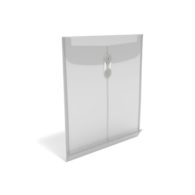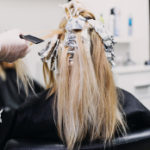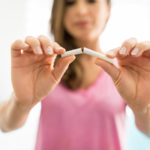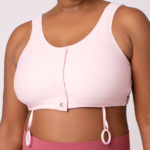The Masthead® Guide to Breast Surgery
Following are our time-tested instructions and advice, updated for the COVID-19 era, to help women get through mastectomy or other breast cancer surgery. Please read them carefully from beginning to end. This was the “tip sheet” compiled by the doctor who created the Elizabeth Pink Surgical Bra®.
I. Get Organized
- Make sure you can videoconference. The global pandemic has ushered in the age of telemedicine. Everything, it seems, is now digital. Be prepared to use your camera on your computer or phone for communication. And don’t forget your portable phone charger so that you can recharge anywhere!
- Create a file of your medical records. In the age of telemedicine, all information will be stored in electronic form on a secure server by your doctors. Create a digital file backup of these records. If you feel more comfortable having hard copies as well, we recommend keeping the following in a clear plastic folder to keep it all together, visible, and accessible:

-
- Printouts and copies of your medical information such as insurance information, regular doctors, prior hospitalizations and medication list
- Your pre-op (before surgery) and post-op (after surgery) instructions
- Appointment dates, physician information and phone number
- Nurse and/or administrator who book your appointments
- Notes
- Give consent so that your physicians can share information. These days, information can be sent between physicians electronically, but you must give permission for this to occur. Make sure you understand what you are signing.
- Consider arranging for a home nurse. If appropriate, arrange for Visiting Nurse Association (VNA) or other home nurse service follow-up so that you can have a nurse check on you at home rather than make a trip to an office for your first post-op visit. Make sure you have this set up in advance.
- Fill regular and post-op prescriptions ahead of time. You will need to have them when you leave the hospital. There are new protocols to enhance your recovery, so there may be new medications or supplements that you have previously never seen. Many physicians will introduce you to ERAS (Enhanced Recovery After Surgery), a strict regimen to reduce complications, improve nutrition and healing, reduce nausea and pain and, most importantly, reduce your need for narcotics. You may be asked to take some of the following: acetaminophen, gabapentin, and a clear nutritional supplement drink at home the day of surgery.
- Have the following in the house for your recovery: stool softener (since pain medication might give you mild constipation); moist wipes to help you stay clean; wound supplies (sterile gauze, surgical gloves, tape, alcohol wipes and antibiotic ointment.
- Make sure you have a working digital thermometer at home. You will need to check your temperature and report symptoms to a nurse who will call you pre-operatively to review instructions.
- If you tend to get nauseated from anesthesia or pain medication, mention this to your physician, surgeon, and anesthesiologist before surgery. If you are extremely nervous, you can also ask for a sedative for the night before surgery to help you sleep.

- Do your hair or have your hair done. If possible, get your hair cut, colored, blown-dry or whatever you normally do before your surgery. Most likely you won’t be allowed to shower or blow-dry your hair for a few days because you can’t lift your arms. If you get your nails done, skip the polish, because you probably won’t be able to wear it in the operating room. Shave or wax your legs and underarms, if necessary, before your surgery, because you won’t be able to lift your arms or reach down to your legs for a while.
- Inform your employer that you will be out on medical leave for at least 2 weeks. You might feel up to going back earlier, but it’s best to give yourself a buffer.
- Discuss payments and coverage with your health insurer before your surgery. Get all pre-authorizations in writing, and make sure you are aware of any out-of-pocket costs you will have to pay. There is sometimes a difference between what you are billed for and what your insurance will pay, and you should be prepared ahead of time to avoid surprises. Also, if you have a health care flex spending account that you can use for deductibles, transportation, parking, and other non-covered medical expenses, make sure you keep all necessary receipts in your handy folder.
- Get your house in order — literally. Pay bills, complete financial chores, get the laundry done, prepare and freeze microwave meals, and line up help for yourself, your house and family members who need it. Move things from high shelves in your kitchen to counter height or get an arm extender/grabber. Do any necessary heavy cleaning before your surgery, because pushing a vacuum cleaner or changing sheets will be out of the question for quite a while.
- Go grocery shopping or arrange for food delivery. Nutrition is very important before and after surgery. Think of your surgery as a major workout: you need to eat well before and after so that you can perform well and recover while preserving muscle mass and strength. Having an operation stresses your whole body, leading to lowered immunity and insulin resistance and unintended loss of muscle mass. Make sure you have several days’ worth of groceries for yourself and your family. Ask your physician about nutritional supplements like Ensure Surgery or ClearFast. These drinks provide carbohydrates to reduce insulin resistance after surgery, support immune health and recovery, and improve patient outcome. Also, stock up on crackers, broth-based soups (not creamy) and Jello. These are all easy to digest the first few days at home. Bendable straws will make liquids easier to drink. Plan to eat a well-balanced diet focusing on trying to eat at least 50 gm of protein for 7 days after surgery.

- Stop smoking or vaping. Patients who consume nicotine and undergo surgery have an increased risk of post-surgery heart and lung complications. And they can even have problems related to anesthesia given during surgery. In addition, smoking and vaping make it more difficult for the surgical wound to heal and may increase the risk of an infection. Your doctor will recommend that you stop smoking three weeks before surgery to avoid any complications. Smoking is known to cause lung cancer and many other health problems. If you are a smoker, this is an excellent time to stop for good.
- Stop use of alcohol and controlled substances at least a week before surgery. Discuss this with your doctor prior to surgery. Withholding information about your drug and alcohol habits from your surgeon, who is bound by doctor-patient confidentiality, could be life-threatening.
- Make note of all medications and supplements that you are taking. Discuss each one with your physician. Some supplements may interfere with clotting, the natural coagulation of your blood that keeps you from bleeding to death. The ERAS protocol includes arginine and Omega-3 fatty acids. Speak with your physician about this.
II. Understand the Terminology
Listed below are some terms and brief definitions to help you navigate pre-op diagnostic testing and medical clearance.
- Mammograms: X-rays that are used to detect abnormalities in the breast tissue. Mammography is now done digitally, with images uploaded directly into a computer. Rarely is it done on big plastic sheets anymore. There are several types of mammograms, including tomosynthesis or 3D mammography. Ask the radiology center to send you a copy of the results digitally. Write down the name of your test, screening or diagnostic, and keep the information in your digital and physical folders.
- Ultrasound imaging: High frequency sound waves are used to detect masses or abnormalities in the breast, often in conjunction with, or as follow up to, a mammogram. For some women with dense breasts, this is the only way their doctors can get an accurate look at their breast tissue.
- Breast MRI – This popular imaging technique employs sophisticated magnets to look at breast tissue. The patient lies on her stomach and her breasts are placed through an opening in the table. The resulting scans are used as a baseline, and to rule out any worrisome areas before surgery. The technicians will most likely inject the patient with a contrast dye (to help create clearer images) before or during the procedure, after receiving some medication to ensure there is no allergy to the contrast dye. It’s usually cold and noisy in the MRI room. Some MRI machines are like long, skinny tunnels, while others are more spacious and open. Bring ear plugs, or the MRI center may have headphones with music. Don’t be afraid to ask for sedation if you are nervous or tend to get claustrophobic, since remaining still is crucial for accuracy.
- EKG – An EKG, or electrocardiogram, checks your heart rhythms. Little electrodes are attached via suction cups to spots on your chest and arms (no punctures or injections), and the machine measures and records the results on a paper scroll – it’s a painless and very short procedure.
- Chest X-ray – A standard painless chest x-ray is done to rule out any pulmonary (lung) disease or infection prior to surgery.
- Blood tests – A doctor, nurse or specialized “phlebotomist” (blood drawer) will insert a small needle into a vein in your arm and fill a few tubes of blood. If you have had a lymph node dissection (removal of one or more of your lymph nodes for testing) in the past, avoid having that arm used for drawing blood. Physicians look at your blood chemistries to determine your general health. They review your actual blood cell counts to make sure that your blood is clotting properly and that you are not anemic (low in red blood cell count). The tests are important predictors of your risk of infection, and of how you will heal after surgery.
- Medical clearance – This means screening before surgery for infectious disease risk (i.e. COVID-19) Make sure you have a digital thermometer to check for fever. Your surgeons will discuss any issues related to pre-existing conditions with your primary care doctor, cardiologist, or gynecologist before surgery. This is part of the pre-op preparations, and why we encourage you to keep all of your medical paperwork in one central folder. Physicians may ask confusing questions about your past medical care and you need to be ready.
III. Prepare for Surgery
- Pack your hospital or surgery center “go bag” with a few additional personal essentials, including: eyeglass case if you wear glasses (don’t wear your contact lenses); list of people and emails or phone numbers you want to call or text (or have someone else call or text) letting them know that you are out of surgery and okay; loose, comfortable clothing for the trip home. Many surgeries are done on an outpatient basis at a surgical center or “23-hour” admission at the main hospital so that patients can avoid being an inpatient.
- Leave jewelry, wallet, and other valuables at home. It’s possible you won’t be allowed to have anyone accompany you and hold your things, so do not carry valuables or money. You don’t need money while you are in the hospital or surgery center. Your phone will be kept safe with your packed bag while you are in surgery and recovery. Remember to pack your phone charger! Ask your designated driver/pick up person to be ready at all times for a call. Things can get delayed or postponed. Mostly you will be asked for your birthday, your full name, and possibly the last 4 digits of your social security number. Don’t forget photo ID and proof of insurance. You can store these on your phone.
- Ask which medications are okay to take the night before surgery. Specifically ask if you are supposed to take your regular medications and if you are allowed a sip of water. It is dangerous to have food contents in your stomach when you have anesthesia, as it might cause you to “aspirate” or get stomach contents into your lungs if you vomit.
- Loosen or unscrew the tops of your medication bottles and leave them on your bedside table in advance so you don’t have to struggle with them after your surgery – at first you will be too weak and shouldn’t strain your chest and arm muscles. However, make sure to keep these partially opened medication bottles away from children.
IV. The Day of Your Surgery
- Take a thorough shower using anti-bacterial soap and, if instructed, Hibicleanse or other antiseptic antimicrobial wipes. The morning of your surgery, since it might be a while before you can shower again, don’t put on deodorant or perfume, lotions, hair gel or powders. Do not put in contact lenses; wear your glasses instead.
- Leave early enough to get to the hospital on time. Wait in the car until they tell you to come into the hospital or surgery center. Follow their instructions.
- Be patient. Your procedure may be delayed. It does not reflect a disregard for timely care. Cases earlier in the day tend to be “on time.” As the day goes on, delays are inevitable.
- Check in and provide insurance information. Some of the registry and information gathering can be done remotely prior to your date of procedure, but they may ask you to fill out paper forms and there is a lot of repetition.
- Answer questions. When it’s time for your surgery, a series of providers (nurse, anesthesiologist) will ask you for your identifying information such as name date of birth, and review your allergies to medications and other allergens, such as adhesives, latex, etc. Make sure that you carry a list if you can’t remember easily (or if you have many!)
- Change into a hospital gown. You will put all of your clothes and belongings into a bag that will be returned to you. A provider will come into the consult room and take your “vitals” (temperature, heart rate, blood pressure, etc.) and put an intravenous needle with tube (IV) in your arm. If you are having a lymph node biopsy, you may have an injection of dye to locate the nodes during surgery.
- You will be taken into the pre-op waiting area where the surgeons will come over and talk to you. They may also make some markings on your skin with a purple surgical marker. These purple markings will eventually wear off, or you can remove them safely after a couple of weeks with an alcohol pad.
- The nurse and anesthesiologist will prepare you for your surgery on a mobile bed and then help you relax before the procedure begins. Often they will perform a “time out” where the whole team reviews and focuses on the plan for your surgery. This is usually the last thing that you remember before your surgery. It’s reassuring.

- Waking up. In what seems like a minute, but could actually be several hours, you will be awake and in a recovery room bay. A nurse will continue observing you and monitoring your blood pressure, heart rhythm, and oxygenation. You may feel groggy and disoriented. If you are cold, request extra blankets and, if you are nauseated or in pain, ask for medication immediately. You will come out of the operating room in a surgical bra, preferably our Masthead Elizabeth Pink Surgical Bra® or Judy Long-Line Bra — the most comfortable, convenient and effective surgical bras on the market. If you were put in a different brand in the OR, you can purchase a Masthead bra from our online store at mastheadpink.com.
- When you are stable, you will most likely be sent home. You must be driven home or escorted by a designated relative or friend. You may experience a little discomfort or just a tightness across your chest. However, if you are in pain, follow the instructions of your physician.
V. Dealing with Drains
- About JP drains. After a mastectomy, you may have tubes coming out of your surgical site that will drain fluid into a little grenade-shaped bulb called a JP (Jackson-Pratt) drain. If you’re wearing the Elizabeth Pink Surgical Bra®, your drains will exit through an opening in the side of the bra rather than under the elastic binding and thus the drain tubing won’t crimp or pinch. The drains tubes pull excess fluid from the surgical site and are very important in preventing complications such an infection, hematoma (buildup of blood) or seroma (buildup of fluids). The fluid then collects, because of suction, in the bulb. When the bulb becomes filled with fluid, it’s time to empty it. The nurses will do this while you are in the hospital. They first stabilize and “milk” the drain, then measure the output and note its color, and finally empty the fluid from the bulb. You will do this when you are home and it’s important to get it right. Click here to watch our instructive video on How to Milk a JP Drain.
- Learn to manage your drains. Hospitals should assign a nurse or physician’s assistant to teach you how to manage your drains or you may have a nurse come directly to your home. Regardless, it helps to have the instructions written down. It’s hard to remember anything they tell you immediately after surgery because the anesthesia effect is still lingering and you’re often on pain medication which makes it hard to remember things. Click here for drain care instructions.
- Keep a drain log. The Elizabeth Pink Surgical Bra® has a small ring on each side that opens to attach to your drain bulbs, so you have an easy way to support the bulb without having to wear a fanny pack or use safety pins or your pants pockets. Your drain log will be a detailed chart recording each drain output and the color of the fluid. Click here to download a copy of our JP drain log. Start recording with your first emptying at home. This helps the doctor track your progress.

- Relieve underarm pressure. One or both of your underarms might be sore after surgery. Use the Masthead Axillapilla® to take the pressure off your axillary incision (if you have one), or to reduce the pressure on your shoulders and upper back from any swelling you may have. The soft pillow is also wonderful to use as a neck or lower back support.
- If you’re in pain, speak up. Do not suffer in silence or think that something more can’t be done for pain. Reach out to your nurse or doctor via telehealth if you are in pain or your medication doesn’t seem right. Some pain medications can make you itchy – if you are experiencing this, please ask for Benadryl or other antihistamine. Your doctor might be able to change your pain medication to one that doesn’t cause itching.
VI. Post-Surgery Tips
- You will find that you are very tired for several days after surgery, maybe even longer. The best thing to do is rest. Think of your surgery as a major athletic event. Allow yourself time to recover.
- Driving is not recommended when you are still on pain medication or if you have your drains in place. It is hard to make quick movements and to turn your body when backing up. Many follow-up appointments can be accomplished through tele-health.
- When riding in the car, use our Axillapilla® under the seat belt so that the shoulder harness has some padding. The seatbelt crossing your chest may be uncomfortable for a while.
- Do not lift, push or pull anything heavier than 5 pounds for 6 weeks after surgery. Do not attempt to close car hatchbacks. If you must go to the grocery store, have someone accompany you, or ask for a store staffer to help, and/or for curbside pickup or home delivery. If you have young children, teach them to climb up into their car seats and then you can do the buckling. If your child is still in a crib, arrange for help. If he or she is about ready to go into a bed, now is a great time to encourage this transition!
- Sleep on an incline and use plenty of pillows to prop your arms. Ask for help to sit up. Do not push off the bed to get out. Learn to roll to your side or just use your abdominal muscles.
- Personal Hygiene. If you were told not to shower, take a sponge bath. Have someone help you wash your hair in the sink or at a local salon, or try dry shampoo. If you are permitted to shower, use our Post-Surgery Shower Lanyard to suspend your drain bulbs. If you are supposed to stay away from bathing, use moist wipes to stay refreshed and clean.
- It is important to get up and walk. Start slowly.
- Anti-scarring treatment varies by plastic surgeon. Ask what kind of lotion or ointment your doctor recommends to reduce the likelihood of scars. Do not pull your steri-strips (which hold your incision closed) off your incision. Let them fall off on their own, which could take up to two weeks. The longer they stay on, the better.
- Keep your bra on! Most surgeons will recommend wearing the surgical bra at least until the drains are removed. After the drains are removed, you can cut off the loops and rings and wear your Elizabeth Pink Surgical Bra® for several more weeks if you wish. Ask your physician if it is okay to switch to another bra, such as our supportive Estelle Recovery Bra, which has a front closure and a soft pocketed lining.
- Beware of visitors bearing germs. In the COVID age, social distancing rules about visitors MUST be followed, even in your own home. You do not want to get sick and end up coughing and rupturing sutures, or even worse, developing an infection. Assign one family member as the contact person for visit requests and to ensure distancing, mask-wearing and disinfecting.
- It’s normal to feel occasional spasms of the chest muscle or shuddering pains in your breast. This indicates that the nerves to the muscle are repairing themselves. Your breasts may feel numb and this is normal.
- Caffeine withdrawal. If you are a coffee drinker, you may develop a caffeine withdrawal headache the day after surgery. Coffee is the best remedy and it keeps most people regular.
- Your doctor will probably prescribe one or more of the following pain medications if needed for your post-op comfort. “Surgical doses” of Tylenol have become the norm since it’s an excellent non-narcotic pain reliever at specific doses. Make sure to follow exactly what your physician recommends. Here are the most current regimens associated with post-op protocol:
- Tylenol (acetaminophen) 1 gm three times a day. Celebrex 200 mg twice a day (or another ibuprophen non-steroidal). Follow instructions of your physician if they differ.
- Oxycodone-IR (immediate release) 5-10 mg if necessary for breakthrough pain with the Tylenol
- Colace (stool softener): 250mg twice a day
- MiraLax (laxative): One tablespoon diluted in 8 ounces of water once a day
- Ativan: 1mg every 8 hours as needed for muscle spasms
- Zofran: 8mg oral dissolving tablet placed on tongue every 6 hours as needed for nausea
- Give your spouse, partner or child the official job as “back scratcher.” It will be very hard to reach over or behind your head and reach your back.
- Expect some mood swings. Breast surgery and mastectomy involve removal of breast tissue which makes estrogen. It may take some time for your body to adjust to these changes. Even after surgery and anesthesia, some women find that their hormones are in flux and they feel moody or sad. Don’t be afraid to mention this to your doctors, but be aware that with time, your hormone levels will most likely normalize. If you are having surgery on your ovaries at the same time, your oncologist or gynecologist can help with this transition as well.
VII. Easing Back into Normal Activity
- Family life – If you have young children, take it easy. Picking up anything over 5 pounds, including a child, is not recommended for 6 weeks after surgery. Instead, have them come and sit on your lap or next to you. Ease carefully back into cooking, shopping, and housework. When you get tired, take a break.
- Don’t strain yourself. Opening jars, turning doorknobs, and unscrewing lids (anything that requires strain and twisting) will be difficult. Get a gripper pad or jar opening tool, or ask someone to help you.
- Continue to order groceries or takeout meals for home delivery or curbside pickup and ask the store to load the groceries into your car, if possible. Tell them that you cannot lift anything over 5 pounds.
- Indulge in rest. Napping is a great thing. Catch up on movies and streaming. Start that book you’ve been meaning to read.
- Wear comfortable clothes for a while. Hoodies, vests and sweaters with front zippers or buttons are ideal. It’s best not to pull things over your head.
- Returning to work greatly depends on the type of work you do. For highly physical jobs, you may need to take off 4-6 weeks. If you work behind a computer, you may find that you can get back to work at least part-time within a week. Remember that you may tire easily and you should not stress yourself. Doing too much too soon, such as pulling/pushing heavy objects, is the easiest way to bring on complications. And remember that while you are on pain medications you should not drive, make any big decisions, operate heavy machinery, or try to read and sign any complex documents.

- Getting back into exercise. Some women find that working out helps with both the mental and physical recovery. But make sure your doctor says it’s okay. If your recovery is smooth and without complications, you can begin with walking—it’s a good idea to walk with a friend and have him or her carry anything you need. Vests with pockets are great during recovery. If your goal is to get back to high impact activities like running, discuss this with your doctor. You may want to wear two workout bras for extra support and to keep your chest steady, with little bounce.
- Resuming sexual activity is a highly personal topic. Once your physician gives you the green light from a medically standpoint, make sure you feel physically and emotionally ready. There is really no right or wrong time once your incisions have healed.
VIII. Down the Road
- Keep a journal and take a few pictures. You will appreciate looking back on your recovery and helping others who may have questions.
- Drain removal. Usually, between one and two weeks after your surgery, your drains can be removed. The drain output at that point should be minimal and straw-colored. Your physician may decide to pull only 1 or 2 of the drains at the first post-op visit, but don’t be disheartened. Take a Tylenol or stronger painkiller before your appointment to avoid discomfort. Most surgeons or visiting nurses will not stitch the drain openings closed but will allow them to heal on their own. You can cover them with gauze at first and then a band-aid.
- Keep your incision wounds protected. Secure sterile gauze with paper tape or a sturdy band-aid over your drain openings and a piece of gauze over the mastectomy incisions so that there is no rubbing or abrasion. If you are allergic to tape or dressing, try hypoallergenic surgical tape or another material your skin can tolerate.
- Pathology Report. Depending on the reason for your surgery, you will most likely receive a pathology report about the tissue removed during the mastectomy. Your physician will discuss this fully with you, but do not be afraid to ask questions if you have any.

- Shopping for bras. Avoid the urge to go out and buy new bras too soon because you’ll be swollen for 6 weeks or more. Find one or two comfortable “stage 2” or everyday bras like the Masthead Estelle Recovery Bra. Once the swelling goes down and your breasts have settled to their final size, you’ll enjoy buying clothes without worrying about returns.
- Follow-up MRI. Some women are worried about whether the surgeon took out all the problem breast tissue. A follow-up MRI can often calm your fears, but your surgeon may not recommend this until six months.
- Complications from surgery. Infections, skin problems and other complications can take a long time to resolve. Don’t be afraid to seek a second opinion if necessary. Everyone heals on a different schedule and even the healthiest people can have problems. Ask questions if something does not seem right. While social media and the internet can provide distraction and some support, be careful about taking advice from unvetted resources. Because each person’s diagnosis, treatment and physician recommendations may vary, do not fall prey to an angry rant on social media that may steer you down a problematic path.
- Follow-up appointments. You will most likely see both your breast surgeon and your plastic surgeon at 3 months, 6 months, and one year after your surgery via telehealth or in person. Contact them earlier if you feel you need to see either physician before those scheduled visits.
We hope the information above helps you navigate your surgery and recovery with ease. Please keep in mind that everyone heals at a different pace and that being a patient requires patience! Waiting to heal and get back to “normal” is always the hardest part of recovery. Also, your own doctor’s instructions should always be followed since he or she knows your individual case.
From all of us at Masthead, have a safe and healthy surgical journey!
Please click here to download a pdf of this guide.


